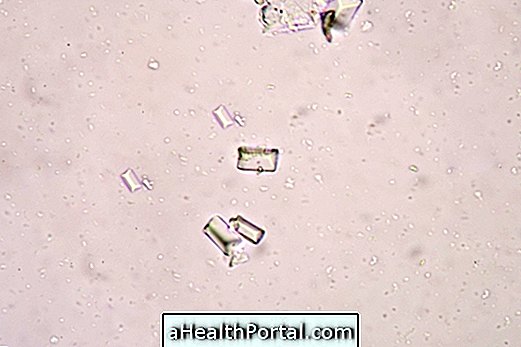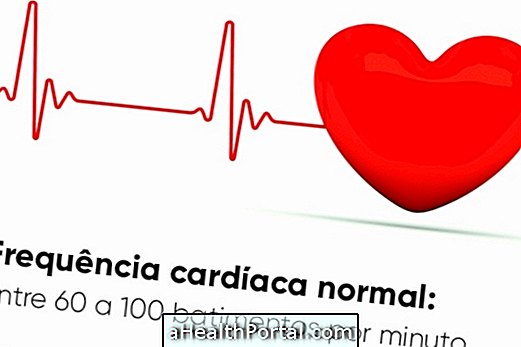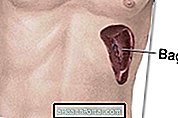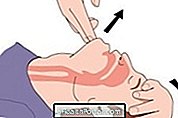The presence of crystals in the urine is usually a normal situation and can happen due to eating habits, little water intake and change in body temperature, for example. However, when crystals are present in higher concentrations in the urine, it may be indicative of some disease, such as renal calculus, gout and urinary infections, for example.
The crystals correspond to the precipitation of substances that may be present in the body, such as medicines and organic compounds such as phosphate, calcium and magnesium, for example. This precipitation can occur due to several situations, mainly due to changes in body temperature, urinary infections, changes in urine pH and high concentration of substances.
The crystals can be identified by means of the urine test, called EAS, in which the urine sample collected and sent to the laboratory is analyzed through the microscope, being possible to identify the presence of crystals and other abnormal elements in the urine. In addition, the EAS exam indicates the pH of the urine as well as the presence of bacteria, for example. Learn more about urinalysis and how to do it.

Symptoms of crystals in the urine
The presence of crystals usually does not cause symptoms, as it may represent something normal. However, when found in high concentrations, the person may experience pain in the kidneys, difficulty urinating, abdominal pain, nausea and increased body temperature. In addition, it may be noticeable change in urine color, which may vary according to the reason that led to the formation of crystals.
In the presence of these symptoms, the most recommended is to go to the general practitioner or nephrologist to be asked for tests and thus the diagnosis and treatment can be made.
What can it be
The result of the urine test may indicate the presence of crystals, indicating which type is observed. Normally in the report it is indicated that there are rare, few, numerous or numerous crystals, which assists the medium in the diagnostic process. The main causes that lead to the formation of crystals are:
- Dehydration : The low water intake causes the concentration of the crystalline substances to increase due to the low concentration of water. This stimulates the precipitation of salts, resulting in the formation of crystals;
- Use of medicines : The use of some medicines may precipitate and lead to the formation of some crystals, such as sulfonamide crystal and ampicillin crystal, for example;
- Urinary infections : The presence of microorganisms in the urinary system can lead to the formation of crystals due to changes in pH, which may favor the precipitation of some compounds, such as triple phosphate crystal, for example, that can be found in genitourinary infections;
- Hyperproteic diet : Excessive consumption of proteins can overwhelm the kidneys and result in the formation of crystals due to the increased concentration of the byproduct of protein digestion, uric acid, and microscopic crystals of uric acid;
- Gout : Gout is an inflammatory and painful disease caused by increased uric acid concentration in the blood, but which can also be identified in the urine, being perceived crystals of uric acid;
- Kidney stones: Kidney stones, also called kidney stones or urolithiasis, can occur due to a number of factors, being perceived through characteristic symptoms, but also through urinalysis, where numerous crystals of oxalate and calcium, for example.
The presence of crystals in the urine may also be the result of inborn errors of metabolism or indicative of diseases in the liver, for example. Therefore, it is important that if any change in the urine test is identified, the doctor requests biochemical or imaging tests to aid the diagnosis and thus initiate the best treatment.
Types of crystals
The crystal type is determined by the cause and pH of the urine, the main crystals being:
- Calcium oxalate crystal, which has an envelope shape and is usually present in acid or neutral pH urine. In addition to being considered a normal finding, when in low concentrations, it may be indicative of renal calculus and is usually related to diet rich in calcium and intake of little water, for example. This type of crystal can also be identified in large amounts in diabetes mellitus, liver disease, severe kidney disease and as a consequence of a diet rich in vitamin C, for example;
- Uric acid crystal, which is usually found in urine of acid pH and is usually related to the hyperproteic diet, since uric acid is a byproduct of protein degradation. Thus, diets rich in protein lead to accumulation and precipitation of uric acid. In addition, the presence of uric acid crystals in the urine may be indicative of gout and chronic nephritis, for example;
- Triple phosphate crystal, which is found in urine of alkaline pH and consists of phosphate, magnesium and ammonia. This type of crystal at high concentrations may be indicative of cystitis and hypertrophy of the prostate in the case of men.
Some diseases of the liver may be indicated by the presence of some types of crystals in the urine, such as crystal tyrosine, leucine, bilirubin, cystine and ammonium biurate, for example. The presence of leucine crystals in the urine, for example, may initiate cirrhosis or viral hepatitis, and other tests are required to confirm the diagnosis.























